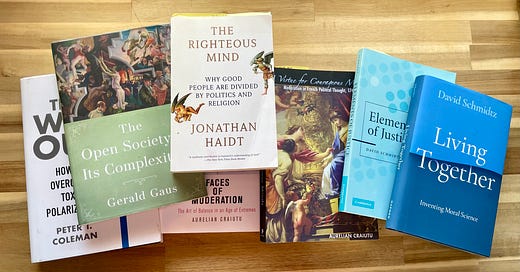Photo: An assortment of (some of) the books on moderation I’ve been playing with.
Sh*tty First Draft!
I had a meeting with my research assistant this week and we’re at a fun milestone: by tomorrow, I should have a shitty first draft of the book!
It’s very rough, will need a lot of editing, and may change shape (again) once an agent or editor gets his or her hands on it, but the main ideas are there. And that’s all we can ask for from a shitty first draft.
The table of contents hasn’t changed dramatically since I posted last, but here’s what it looks like right now:
Table of Contents
Introduction
Part I: Theoretical Foundations
Complexity
Humility
Tradeoffs
Social Individualism
Humans Matter
Toleration
Part II: Practical Applications
Policy Guide: Criminal justice, immigration, healthcare
Life Guide: Parenting, wellness, religion, politics
Conclusion
The word count will likely change a lot once the editing process starts, but it’s around 50k words now, which is about what I was shooting for at this stage.
Some General Thoughts
Overall, I’m pretty happy with it. As you can see from recent Substack posts, I’ve incorporated the idea of justice in a map from David Schmidtz and tweaked it a bit to think about moral landscapes in 4D. I like this metaphor, since it encourages the reader to really move beyond the 2D political spectrum binary we’ve created and start exploring the moral, social, and political landscape in a much more creative and imaginative way. It’s also related in some ways to the metaphor of a policy watershed that I used in my last book, which readers told me they found intellectually helpful.
But this metaphor isn’t just rhetorical. It’s my firm belief that, just like Orwell’s Newspeak, limiting ourselves to a single 2D view of the world actually limits our political and moral imagination in really dangerous ways. A lack of imagination in the moral and political realm contributes to the political and moral tunnel vision, which in turn feeds our polarization and partisanship.
Moreover, people who see only two options - both of which kind of suck - are likely to become either apathetic or angry.
The 2D myth also harms the very concept of moderation, tricking people into thinking that the moderate middle has to exist in between these two crap extremes. Smack in the middle of two awful positions isn’t a particularly attractive or defensible position either.
What I’m really encouraging readers of the book (and the Substack) to do is to escape the 2D spectrum we’ve been stuck in, grab a compass and a map (and maybe a friend!), and start exploring the wide world of our 4D moral and political landscape. It’s a landscape with a lot of things we recognize - because the human experience exhibits patterns - but it’s also a landscape with a lot of variation because different parts of the landscape require different approaches and because human needs vary across the lifespan, across communities, and across time. That variation invites us to think creatively about solutions that no one else is really talking about but that definitely exist or could exist if we just gave them the chance.
Even if you don’t agree with my particular framing of radical moderation or you think the solutions can or should look different than what I propose, I invite you to get out and explore the broader moral and political terrain of our shared landscape. Whether we all agree or not isn’t the point: maps of the same landscape will look different because people have different goals for making maps. What matters is that we see the vast possibilities that exist and start talking about them. More on this next week!
As always, let me know what you think!





